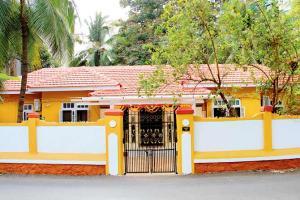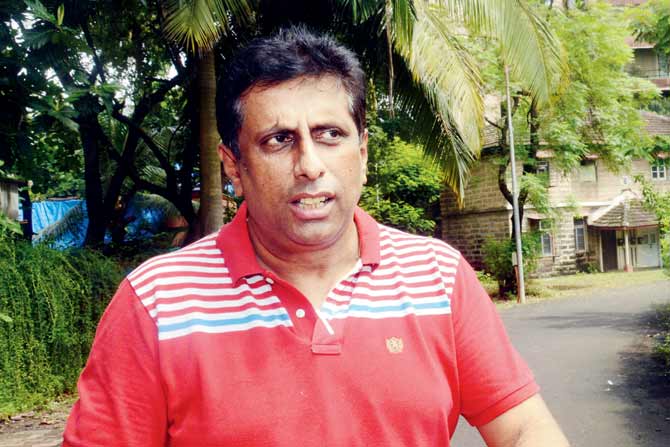In its 100th year, the North Kanara Goud Saraswat Brahmins of Mumbai reveal their best kept secret, which even made Marathi writer PL Deshpande nostalgic

Built in 1936 by the famed Patki and Dadarkar architectural firm, Bhagvati Bhuvan, owned by the Wadekars, is one of the oldest bungalows at Saraswati Baug, Jogeshwari East. Pics/ Satej Shinde
Ninad Wadekar, 48, leads us into a circuitous pathway that opens into Saraswati Baug. Hugged by two-storey stone houses roofed over with Mangalore tiles, this idyllic township is located in Jogeshwari East and easy to miss. This is where the veteran Marathi writer and humourist PL Deshpande (or Pu La to his fans) spent his early years and one of the stories Balpanicha Kaal Sukhacha (Happy Childhood Days), in his memoir, Purchundi, is said to have been inspired by this society. Had he been alive, Deshpande would've been as old as the residential society that turned 100 on July 15 this year. The centenary makes Saraswati Baug, home to the North Kanara Goud Saraswat Brahmins (NKGSB), among the oldest cooperative housing societies in the city, after the Saraswat cooperative housing societies of Gamdevi and Santa Cruz.
ADVERTISEMENT
Who are the NKGSBs?
The Goud Saraswats get their name from the mythical Saraswati river, that is said to have flowed parallel to the Indus, says Bharat Gothoskar, heritage enthusiast and founder of Khaki Tours. Over the centuries, the community has seen multiple waves of migration. The drying up of the river bed, led many to move to Kashmir, eastwards to Bengal and Bihar, and later, down south along the Arabian sea coast. Those who settled in the Konkan regions of Goa and Karwar (in north Karnataka), came to be identified as NKGSBs. Several members of this community moved again to parts of present day Maharashtra, including Bombay, as early as 1680, following the Portuguese Inquisition, residing in the old island city, says Gothoskar. Because of their natural flair for accountancy, they took up jobs of that nature. As the city expanded, a large part of the community shifted once again, this time to suburbs like Jogeshwari. This was early 1900s and Jogeshwari was still an undeveloped neighbourhood. The community purchased a plot of land from the Bombay Municipal Corporation and by 1919 it had built a society for its members.
A self-sustaining society
The community built the first set of 20 stone houses, each comprising two or four duplex flats of approximately 500 metres, where families moved in as tenants. "This also makes it the first plot-owned cooperative housing society in the city, as residents who settled here were not given ownership of the houses, and paid a minimal rent," says 56-year-old resident Abhay Athvankar. "If you notice, the society has been designed like a chess board," he adds.

Dr Ramesh Sadashiv Salgar and his wife, Mrinalini—among the oldest tenanted residents at Saraswati Baug—live in one of the stone houses (pictured here); it was among the first structures to be built after the society was formed in 1919.
Resident Kiran Kamat explains how: Between every two houses, a plot of land was left empty so it could be used as a garden or cultural space. "But, community members realised they could not run the society with rents as little as Rs 1 and Rs 2. So, they started selling the empty plots to GSBs, many of whom built their private bungalows here," adds Kamat, who is also secretary of the Jogeshwari Education Society. The Society, formed by the Saraswats in the early 20th century, runs three schools and a junior and degree college in the vicinity. While the stone buildings have withstood the test of time, some bungalows have made way for apartment buildings.
A dilapidated building in the central courtyard once housed a municipal school and an assembly hall. The hall was named Shantaram Mangesh—founder of the NKGSB Bank who is said to have given financial aid to the society—was built in 1923. Until 2001, it hosted the Sarvajanik Ganpati, which has now found a new home in the Shri Rameshwar Temple, also located within the boundary walls of the society.
"We are like a self-sufficient village," Athvankar says. "We have a school, temple, our own water-harvesting system [Saraswati Baug has a well that collects rain water that is pumped into a tank and supplied to the houses] and a drainage plan, which ensures that the society never faces water-logging."
Skilled residents mean that the community's interaction with the outside world has been limited. One example being 78-year-old Dr Ramesh Sadashiv Salgar and his wife, Mrinalini—among the oldest tenanted residents at Saraswati Baug—who have been the go-to doctors for residents for many decades now. Incidentally, Salgar's father Dr Sadashiv Vitthal Salgar was writer Deshpande's family physician.
Rooted in tradition
The Saraswati Baug community, which is nearly 500 families strong, is fiercely protective of its privacy. However, for the centenary year, it's making an exception. As part of the celebrations, a cultural festival has been planned between December 21 and 25, in the courtyard.

Ninad Wadekar with mum Daya and sister-in-law Meenakshi at their bungalow (left), situated within the boundary walls of the society
"We plan to organise a Marathi musical programme, naataks by different residential groups and talent competitions. The celebrations will end with a fun fair," Kamat says. It's a hark-back to the society's golden years when, residents claim, Saraswati Baug was one of the liveliest cultural spaces in the suburbs.
"Earlier, we would host professional orchestras and Marathi theatre artistes at the Shantaram Mangesh Hall. The money for these events came from the funds we collected during Ganeshotsav," recalls Wadekar whose family bungalow Bhagvati Bhuvan, is one of the oldest and among the best maintained in the society. Built in 1936 by the famed Patki and Dadarkar architectural firm, the bungalow is where Wadekar lived till 1998 when he moved to Goa. But, as is wont, Wadekar, his wife and daughter continue making frequent trips home. The residents at the bungalow total seven, including Wadekar's mum and brother's family.

A top view of Saraswati Baug
Wadekar shows us the trees and plants reared by his octogenarian mum, Daya and sister-in-law Meenakshi, in their sprawling garden. They have everything from bilimbi, lemon, mango and breadfruit trees to a coffee plant. Their neighbour, Athvankar, loves visiting the garden, as Daya indulges him with khatta bilimbis, reserved for him. "All the trees and plants you find in Saraswati Baug, are from our villages back in Karwar and Goa. Every time somebody went there, they brought a plant along with them. It's our gift to the city," Athvanka says. The tulsi vrindavan at Bhagvati Bhuvan is also as old as the structure, and is embellished with replicas of Raja Ravi Varma's paintings that have been made on tiles.
Meenakshi, who moved to Saraswati Baug after she got married into the Wadekar family in 1997, says the shift from "cosmopolitan Khar" to this "conservative" colony, where everyone speaks the same language—Konkani—was refreshing. "It's a separate world within Mumbai. The more you engage with the residents, the more you realise how rooted they are to community. Here, the temple is central to everybody's life. It's rare to see a group of people working together to keep their integrity and customs alive. But this is now home, and I wouldn't be anywhere else in the world. I wish it stays that way."

Kiran Kamat
But that's easier said than done. At the moment, Saraswati Baug is hoping to convince the fourth generation of its residents to stay back and carry on the traditions. "At least 40 of them currently live outside the country," Athvankar says wistfully. Wadekar adds: "The new generation doesn't seem to be very keen [to stay back]. But, even if we are able to pass on something of our tradition to them, it would be a great success story."
Catch up on all the latest Mumbai news, crime news, current affairs, and also a complete guide on Mumbai from food to things to do and events across the city here. Also download the new mid-day Android and iOS apps to get latest updates
 Subscribe today by clicking the link and stay updated with the latest news!" Click here!
Subscribe today by clicking the link and stay updated with the latest news!" Click here!






